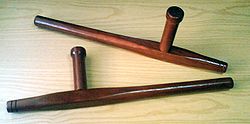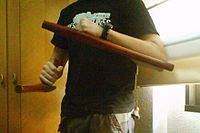- Tonfa
-
The tonfa (Okinawan: トンファー tonfaa, Chinese: 柺; pinyin: guǎi), also known as tong fa or tuifa, is an Okinawan weapon. It is a stick with a handle, and is about 15-20 inches long.[1] It was traditionally made from red oak and wielded in pairs.[citation needed] A similar weapon called the mae sun sawk is used in krabi krabong.
Contents
History
The origin of the tonfa is debated, but experts believe it originated in either China or Indonesia.[citation needed] It is used in both Southeast Asian and Chinese martial arts and was probably brought to Okinawa through their influence. The Chinese believe it was developed from a crutch but Okinawan folklore holds that during the reign of the ruler Shō Shin, restrictions were placed on the use of weaponry in order to stabilize the country after a period of civil war. This restriction is said to have favoured the development of unconventional agricultural tools as weapons of self-defense.[citation needed] In this context, it is said that the tonfa was developed from a wooden handle of a millstone, a common agricultural implement.[citation needed] In modern times, the tonfa was the basis for the PR-24 side-handle police baton but their combat application is different.They are only wooden.
Technique
The tonfa can be gripped by the short perpendicular handle or by the longer main shaft. In defense, if the handle is grasped then the shaft protects the forearm and hand while the knob protects the thumb. If both ends of the shaft are held, the shaft can be used to ward off blows and the handle can be used as a hook to catch the opponent's weapons.
In offense, one can swing the shaft to strike the target. Large amounts of momentum can be imparted to the shaft by twirling the tonfa by the handle. The tonfa can also be wielded in such a way as to use the knob as a striking implement, held either by the handle or by the shaft. One can also stab opponents with the shaft of the tonfa. By holding the shaft and the handle of the tonfa together, one can use it for holding or breaking techniques.
Tonfa are traditionally wielded in pairs, one in each hand. This is unlike police nightsticks, which are generally used alone. As the tonfa can be held in many different ways, education in the use of the tonfa often involves learning how to switch between different grips at high speed. Such techniques require great manual dexterity. As with all Okinawan weapons, many of the forms are reflective of karate techniques.[citation needed]
See also
- Tonfa in popular culture
- Okinawan weapons
References
Further reading
- Robert Paturel and Alain Formaggio, Tonfa sécurité, Chiron éditeur, 2001. OCLC 421954363. ISBN 978-2702706671.
Okinawan kobudō Weapons Styles Categories:- Blunt weapons
- Japanese words and phrases
- Okinawan kobudo
- Weapons of Japan
Wikimedia Foundation. 2010.


